Welcome to a complete guide on indoor potting soil and the components that help plants grow. Discover the secrets of creating the perfect potting soil for your indoor plants, along with easy-to-follow recipes.
What is Soil?

It is easy to mix your own indoor potting mix for your houseplants. It also saves you lots of money!
©13Imagery/Shutterstock.com
Soil is a complex mixture of organic matter, minerals, gases, liquids, and organisms that together support life. It’s one of the most important elements on Earth for sustaining healthy plant growth since it provides plants with essential nutrients and water.
Many types of soil exist, but in general, they all contain four main components: sand, silt, clay, and humus (decomposed organic material). These components interact to form an ideal growing environment for plants by providing them with vital nutrients such as nitrogen, phosphorus, and potassium.
Additionally, the soil has air spaces that allow oxygen to reach the plant’s roots and help it absorb water. Knowing what type of soil is best for your indoor plants can be a tricky task, but with the right potting mix, you can create an environment that will keep them thriving indoors!
What Does Indoor Potting Soil Do?

One important function of indoor potting soil is to anchor the plant so the container doesn’t topple over.
©Firn/iStock via Getty Images
Indoor potting soil is a specially formulated mix of organic matter, minerals, and nutrients that provide your indoor plants with the ideal growing environment.
1. Anchors the Plant
Potting soil anchors houseplants securely, ensuring they remain in place and don’t become uprooted. This soil also provides the perfect environment for roots to spread and grow, allowing the plant to flourish. Potting soil is light and airy, allowing for adequate drainage and airflow while still retaining enough moisture for the plant to absorb. The soil gives the plant stability and the ability to grow long, strong roots. Potting soil is an essential part of keeping houseplants healthy and vibrant.
2. Provides Food and Water
Potting soil is an essential ingredient for indoor houseplants to receive the nutrients, minerals, and water they need to grow and thrive. The soil holds moisture and provides drainage for the roots of the plant while also providing essential nutrients to help the plant absorb the water. Additionally, the soil contains minerals and other organic matter to further nourish the plant and help it grow.
The key to successful houseplant care is ensuring the potting soil is of the highest quality. Good quality soil should hold moisture while still providing adequate drainage. Additionally, the soil should be rich in minerals and organic matter to help the plant absorb the necessary nutrients.
3. Allows Oxygen to Flow
Good potting soil can improve the health of the plant, particularly when it comes to oxygen flow around the plant roots. Potting soil is loose around the roots, allowing oxygen to move freely and reach all parts of the root system. This oxygen flow encourages the roots to develop feeder roots. These fine root hairs help the plant absorb more nutrients and perform photosynthesis more efficiently. Oxygen also helps to keep the soil free of harmful bacteria, allowing the plant to grow and thrive. Overall, having oxygen flow around the roots is crucial for the health of the plant, and high-quality potting soil makes this possible.
Components of Indoor Potting Soil
The different components of indoor potting soil are based on the needs of the plant. For example, cacti like a very coarse and free-draining mixture, while ferns like the opposite. When you make indoor potting soil for these plants, you will use very different ingredients.
1. Vermiculite
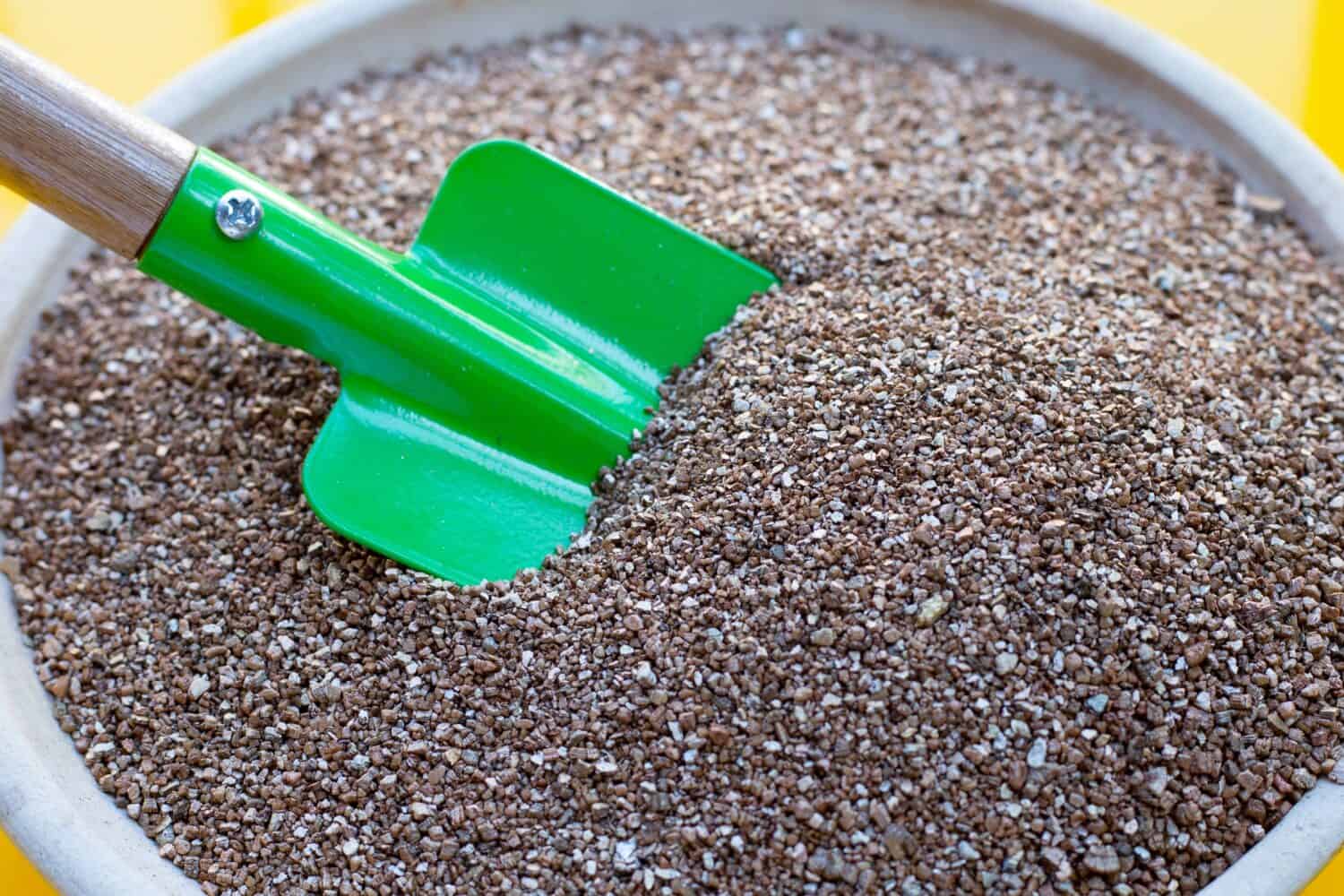
If you need soil aeration, try vermiculite in your indoor potting soil.
©Bowonpat Sakaew/Shutterstock.com
Vermiculite is a lightweight mineral that is known for its heat-resistant and absorbent properties. It is often used in potting soil to provide aeration and drainage, which helps to promote healthy root growth in houseplants. Vermiculite can also help to retain moisture and nutrients, making it an ideal addition to potting soil.
Along with its absorbent properties, vermiculite also has a high cation exchange capacity, which helps to regulate the pH level of the soil and make nutrients more available to plants. In addition, vermiculite helps to prevent compaction of the soil, creating a better environment for root growth. This makes it an ideal amendment for potting soil, as it helps to promote healthy growth and development of houseplants.
2. Perlite
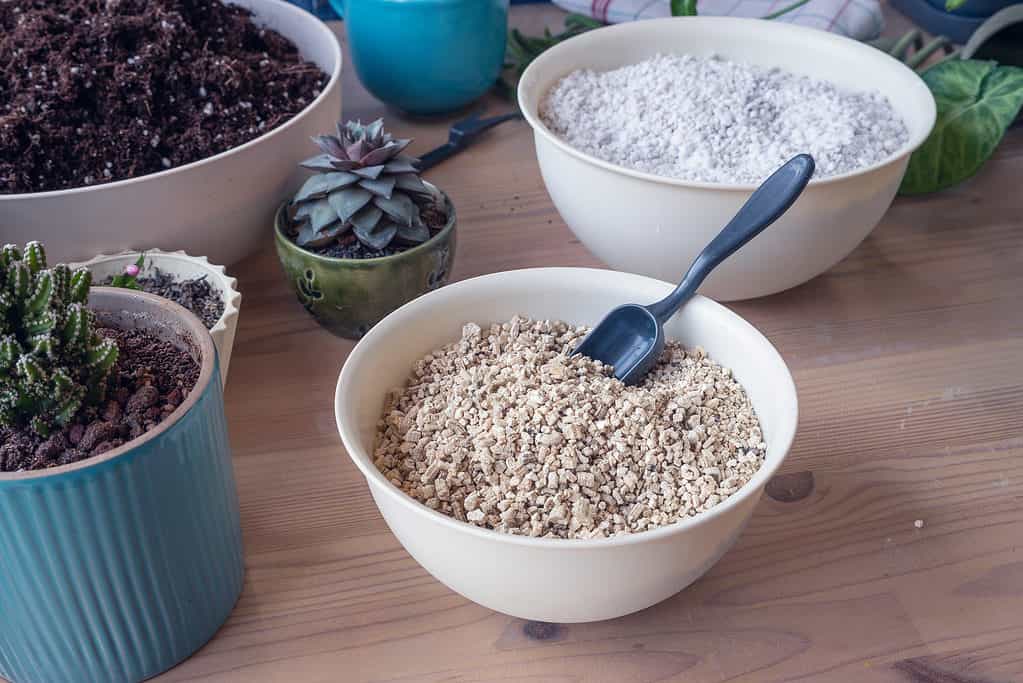
If you need to speed up drainage in your indoor potting soil, try adding perlite.
©iStock.com/CemSelvi
Perlite is a lightweight, porous material that is derived from volcanic glass. It is often used in gardening and horticulture due to its numerous benefits. Perlite is great for houseplants because it helps to aerate and improve drainage in potting soil. It also helps to hold moisture and nutrients while providing necessary oxygen to the roots of the plants.
Perlite is a great addition to potting soil mixes, as it can help to reduce compaction and create a more lightweight product. It can also help to absorb and retain water while providing a better balance of water and oxygen for plants. Additionally, it can help to reduce the risk of over-watering and provide insulation for the roots.
3. Pumice
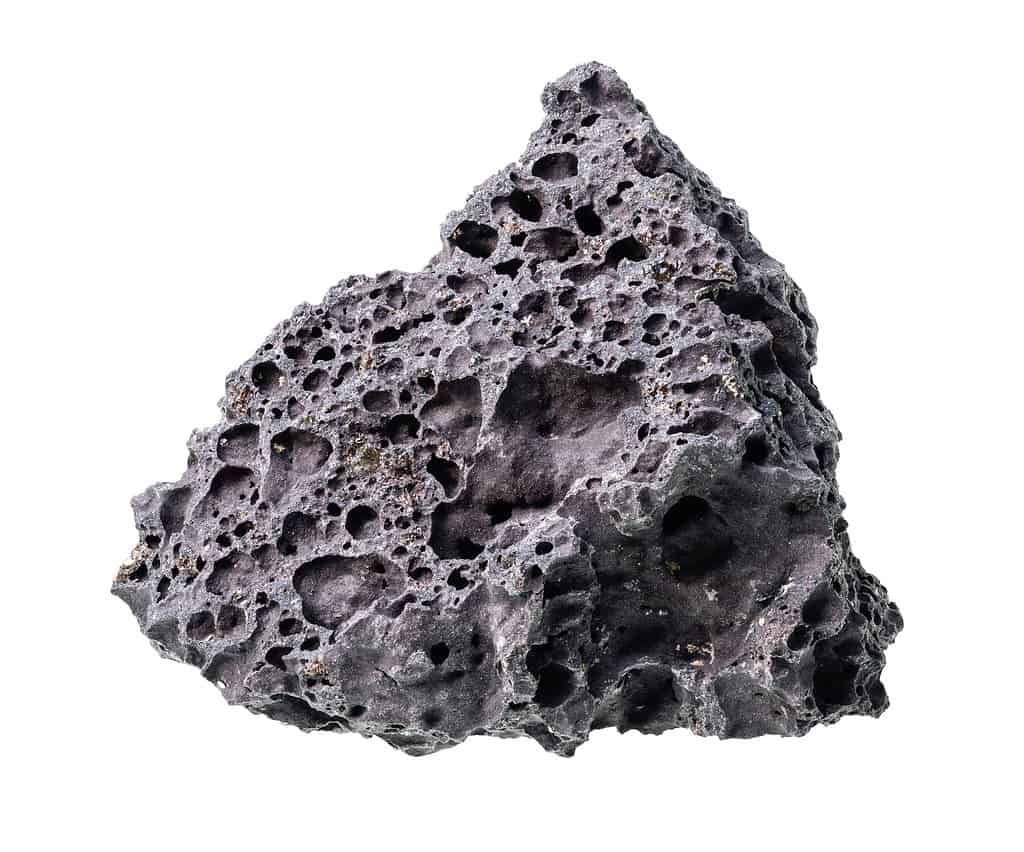
If you need to regulate moisture and add oxygen flow, ground-up pumice stone is a great soil amendment.
©KrimKate/Shutterstock.com
Pumice is a type of volcanic rock that is light and airy with a porous texture. It is ideal for use in potting soil and as a soil amendment for houseplants because it is rich in essential minerals and helps to improve soil drainage and aeration.
Pumice can help prevent compaction of the soil and can provide additional insulation to houseplant roots during colder months. Additionally, pumice helps to retain moisture in the soil while allowing excess water to drain easily. It also helps to reduce soil erosion and nutrient leaching. Pumice can be added to potting soil to make it more porous and aerated, creating a better environment for root growth. It can also be used to improve the texture of clay-based soils and can help to reduce salt buildup in sandy soils.
4. Compost

If you need an excellent plant fertilizer full of beneficial bacteria, add compost to your indoor potting soil.
©Singkham/Shutterstock.com
Compost is a natural soil amendment made from organic matter such as grass clippings, leaves, and vegetable scraps that have been decomposed. It holds moisture and nutrients to help plants grow and can also suppress weeds and diseases. It is also full of beneficial bacteria and microorganisms that plants love.
Houseplants benefit from the addition of compost in their soil, as it helps retain moisture and provides essential nutrients. Compost improves the texture of the soil, making it easier for roots to spread and absorb water and nutrients.
Compost can also be used to make potting soil. When mixed with other materials such as sand, peat, and perlite, compost helps create a well-draining soil blend with the right balance of nutrients for houseplants. Compost is also an effective soil amendment when applied directly to gardens.
5. Peat Moss
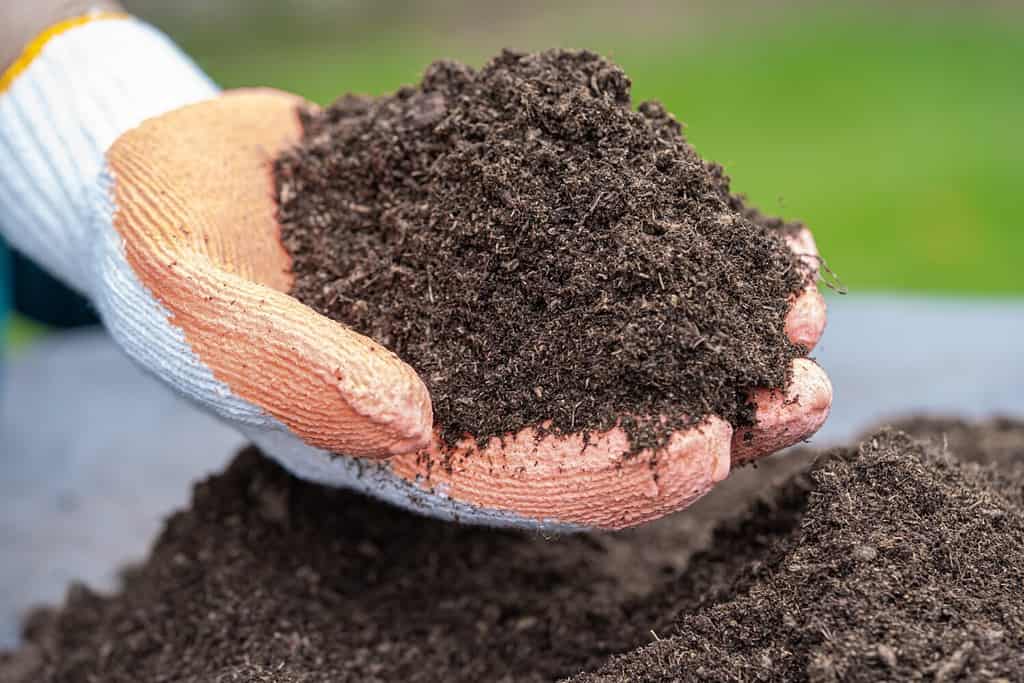
The base for many indoor potting soils is peat moss because it drains very well.
©sasirin pamai/Shutterstock.com
Peat moss is a type of organic matter that is harvested from boggy areas. It is a popular choice for potting soil because of its ability to hold moisture and nutrients. Peat moss is great for houseplants as it is lightweight and can help to improve soil aeration and drainage.
When using peat moss in a potting soil mix, combine it with other materials such as perlite and vermiculite. Peat moss also helps to reduce the amount of fertilizer needed, as it provides a slow release of nutrients. It can also help to reduce the potential for soil-borne diseases. In addition, peat moss is perfect for plants that like an acidic environment.
6. Sand
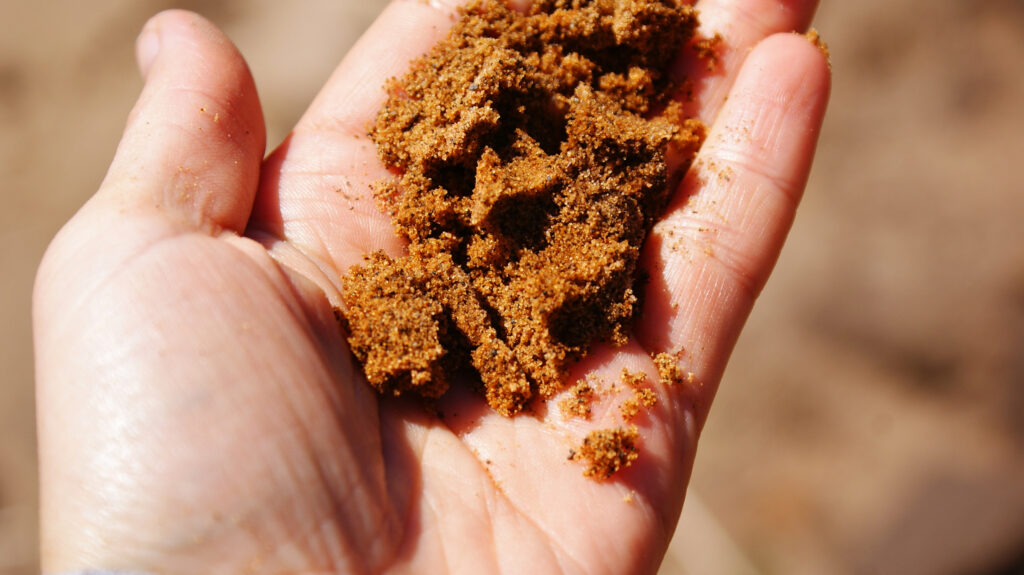
If your plants do not like moisture-retentive soil, add extra sand to your indoor potting soil.
©Svetlana Akhmedova/Shutterstock.com
Sand is a granular material composed of finely divided rock and mineral particles. It has a variety of uses and applications, including making potting soil. Adding sand to potting soil can help houseplants grow better and stronger.
Sand can help plants absorb more water and nutrients from the soil. It also helps loosen the soil, allowing air to reach the roots of the plant. This creates an ideal environment for the roots to take up more water and nutrients and also helps prevent root rot.
Sand also helps reduce soil compaction, which can occur when soil is too dense and doesn’t allow enough air and water to reach the roots. Adding sand to potting soil can help create a well-balanced, nutrient-rich environment for houseplants.
7. Coco Coir
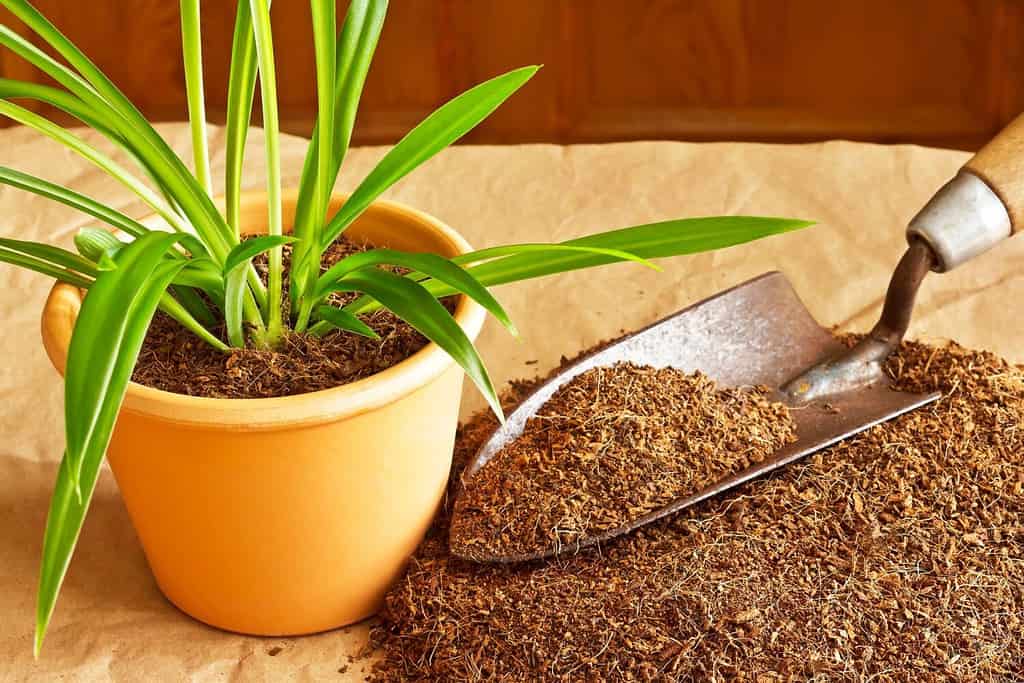
Be sure to pre-moisten both peat moss and coco coir before adding them to indoor potting soil recipes.
©Agenturfotografin/Shutterstock.com
Coco coir is a sustainable, eco-friendly material made from coconut husks, which can be used as an alternative to peat moss. It is a popular choice for potting soil, as it is light and airy and can help to improve soil aeration.
Coco coir also helps to retain moisture, making it ideal for houseplants. Additionally, it is an excellent source of nutrients, providing essential minerals for plants to grow.
Coco coir can be used in many different applications, from garden beds to raised beds to hydroponics. It is also a great option for custom potting soil mixes, as it helps to improve drainage and aeration. Coco coir is an excellent choice for houseplant enthusiasts, as it helps to create the ideal environment for plants to thrive.
8. Worm Castings

When people say worm castings, it is just a polite way of saying worm poop. It is great for plants!
©Jahangir Alam Onuchcha/Shutterstock.com
Worm castings are a type of organic fertilizer produced by worms. They contain beneficial nutrients and microbial organisms that can help houseplants grow and flourish. Worm castings can be used as a standalone fertilizer or as an ingredient in potting soils.
Benefits for houseplants include improved nutrient availability, increased water retention, and improved soil structure. The beneficial microbes in the castings can also help protect plants from pests and diseases.
9. Slow-Release Fertilizer
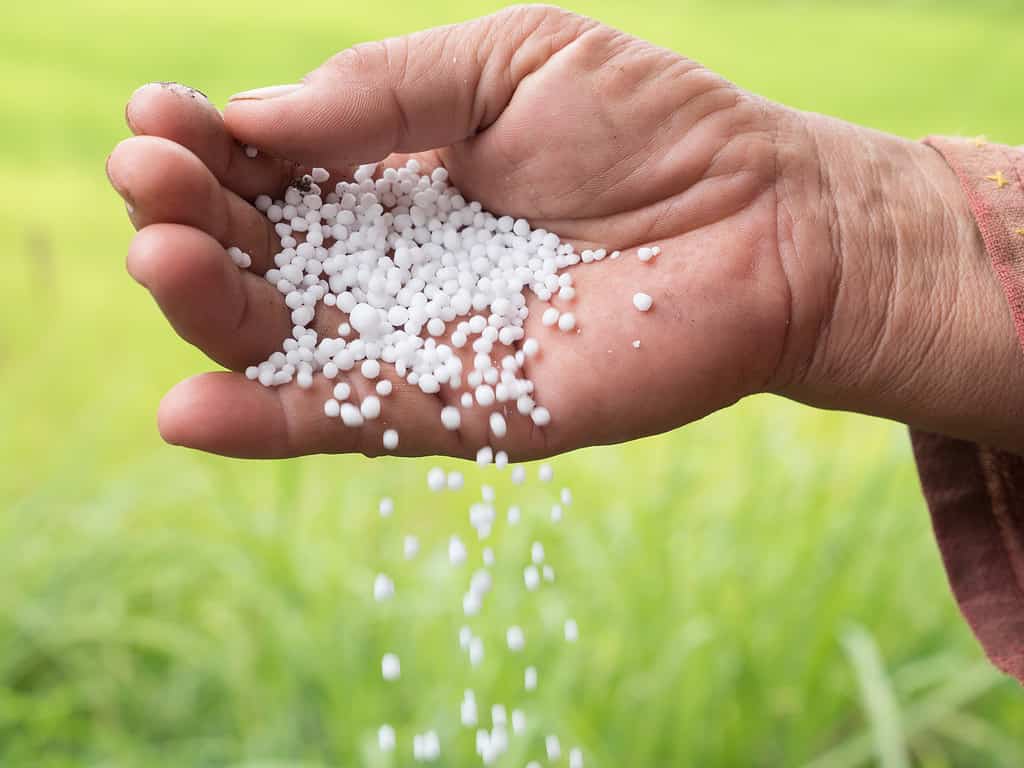
A very inexpensive way to feed your plants is to mix in slow-release fertilizer when you make indoor potting soil. It lasts for many months.
©Singkham/iStock via Getty Images
Slow-release fertilizer is a type of fertilizer specifically designed for plants. It provides a steady release of nutrients to houseplants over a long period of time. This allows plants to access the nutrients they need without becoming overwhelmed. They look like little white, green, or blue balls that you mix into the soil. They slowly dissolve every time you get the soil wet, providing food to the houseplant.
The benefits of slow-release fertilizer are numerous. It prevents nutrient burn and can reduce the amount of fertilizer required. It also helps to reduce leaching and water runoff, keeping more of the nutrients in the soil and around the plant.
10. Gravel
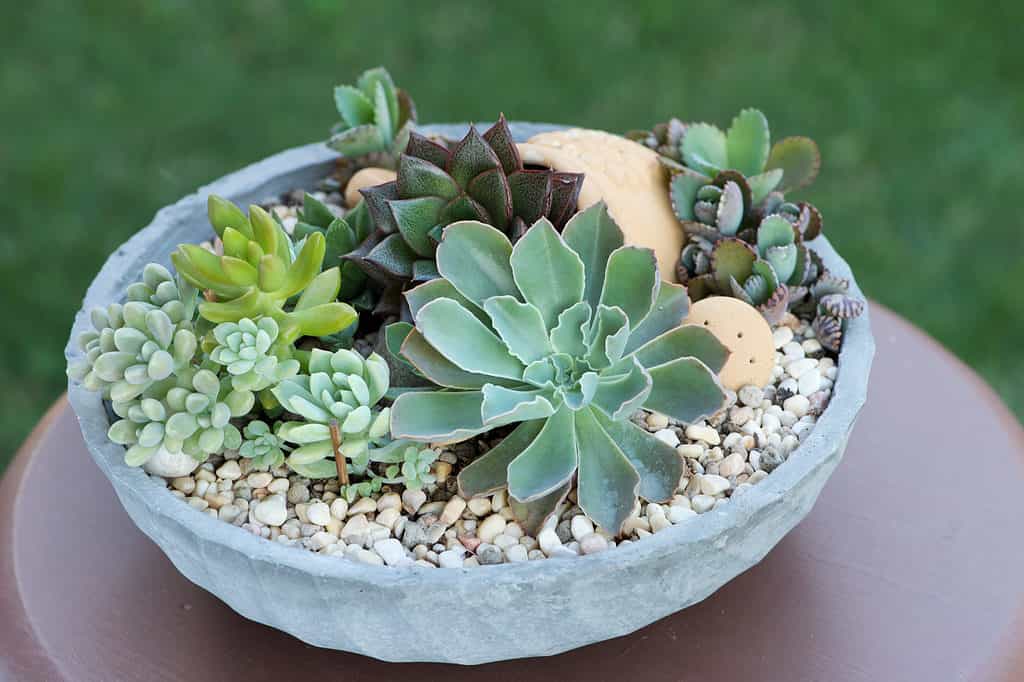
Small gravel and stones are perfect for succulents and bonsai trees that need maximum drainage.
©Christina Siow/Shutterstock.com
Small pebbles, pea gravel, and tiny stones are great for improving the drainage of soil in a pot. Most edible herbs and vegetables don’t need it, but cacti and other desert plants appreciate the extra drainage. However, it is important to rinse any store-bought gravel or pea stones before using them, as they could be covered in silica dust, which is not good for your health. Don’t rinse it off indoors, but do so outside with a hose.
11. Bark Chips
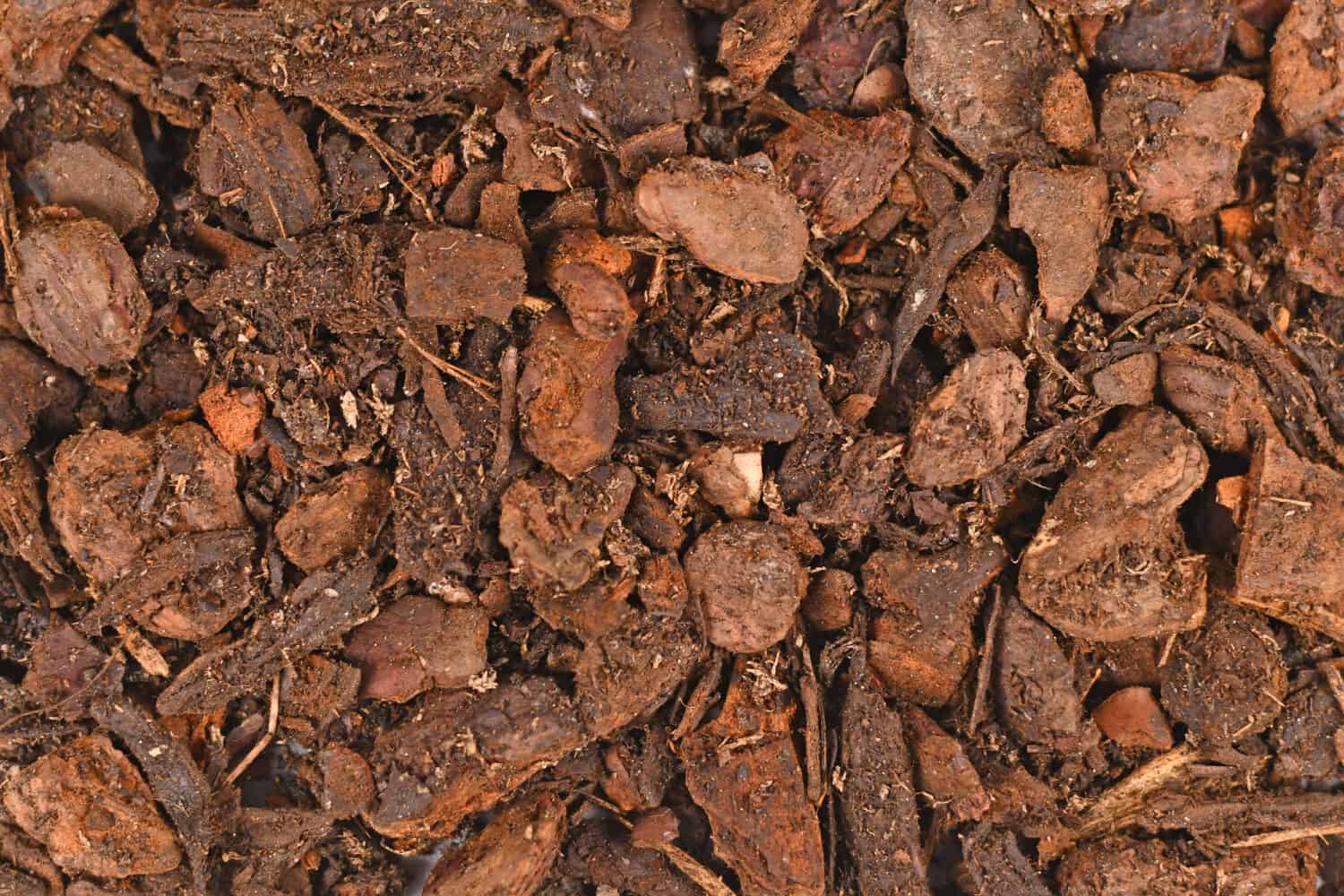
Fir bark (above) and coconut husk fiber can be used interchangeably for indoor potting soil recipes.
©Firn/Shutterstock.com
There are many types of houseplants that enjoy a very chunky potting mix full of bark. You can use tree bark, fir bark, redwood bark, or coconut husk chips to get this nice chunky texture. Some ferns, some tropical plants, orchids, and African violets all thrive in this sort of indoor potting soil.
Bark chips are beneficial for indoor plants because they help to aerate the soil. This encourages better water drainage while also improving air circulation around the roots of plants. Bark chips can be added directly into potting mixes or used as a top dressing when repotting houseplants. They don’t provide any nutrients but do act as a slow-release fertilizer by releasing small amounts of nitrogen, phosphorus, and potassium.
Indoor Potting Soil Recipe for Succulents and Cacti
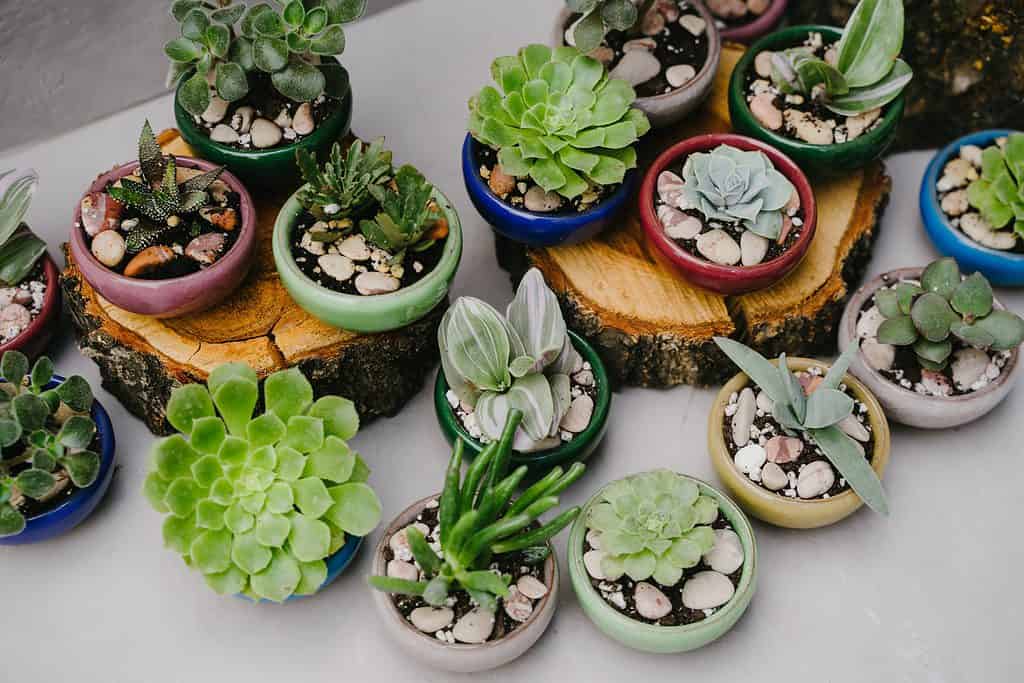
If you plan to grow succulents or cacti, use an indoor potting soil like this one, with plenty of coarse sand.
©Alice Rodnova/Shutterstock.com
Because cacti and succulents require very well-draining soil that does not hold moisture, a coarse, free-draining blend is ideal.
- Use a base of 1 part sphagnum peat moss or coco coir.
- Add 1 part pumice or perlite.
- Add 1 part coarse sand.
- Add 1/2 part vermiculite
- Optional: Mix in 1 part compost or worm castings.
Indoor Potting Soil Recipe for Most Houseplants
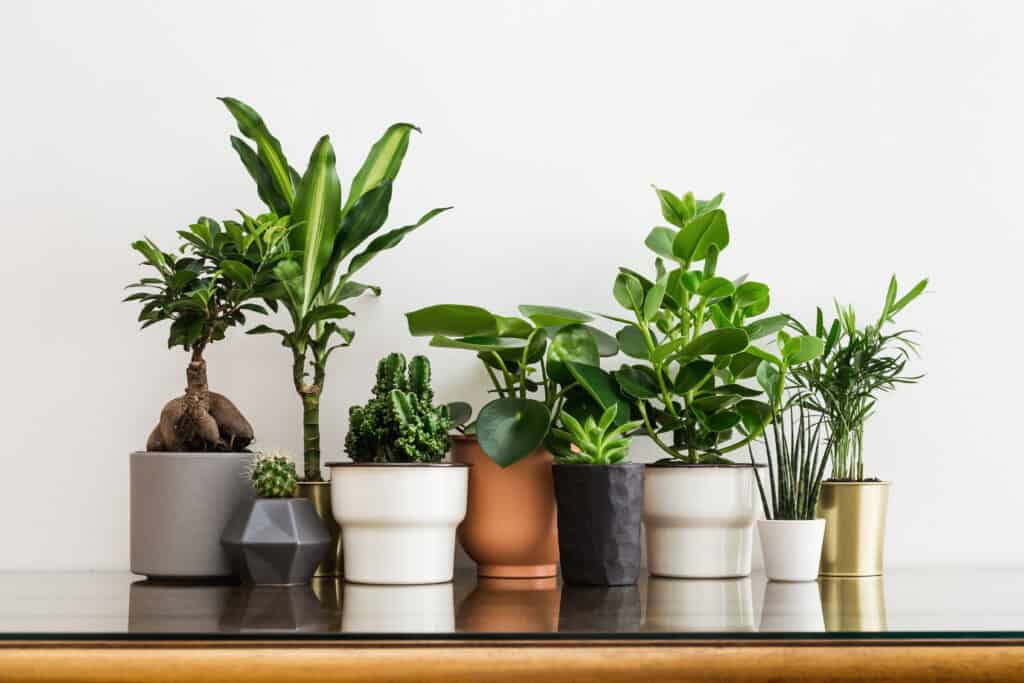
Most types of indoor tropical plants will thrive in this indoor potting soil recipe, so make a large batch.
©Mallmo/Shutterstock.com
The majority of tropical houseplants will thrive in potting soil that remains about as wet as a squeezed-out sponge. This recipe drains well but holds just the right amount of moisture for your plants to enjoy.
- Use a base of 2 gallons of coco coir or sphagnum peat moss.
- Add 1.5 gallons of perlite or pumice.
- Add 2 cups of sand.
- If you used peat moss, lower the acidity of the mixture by adding 3 Tablespoons of garden lime.
- Mix in 2 Tablespoons of slow-release organic fertilizer. You can also use compost or worm castings if you prefer.
Indoor Potting Soil Recipe for Bromeliads

The bright and beautiful bromeliad needs a special type of indoor potting soil.
©Oliver Hoffman/Shutterstock.com
Bromeliads like a nice fluffy indoor potting soil mixture. This recipe contains exactly the right mixture of water retention, aeration, and drainage that these plants prefer.
- Use a base of 1 gallon of peat moss
- Add 1 gallon of bark chips
- Mix in 1 gallon of coarse sand
Indoor Potting Soil Recipe for Aroids
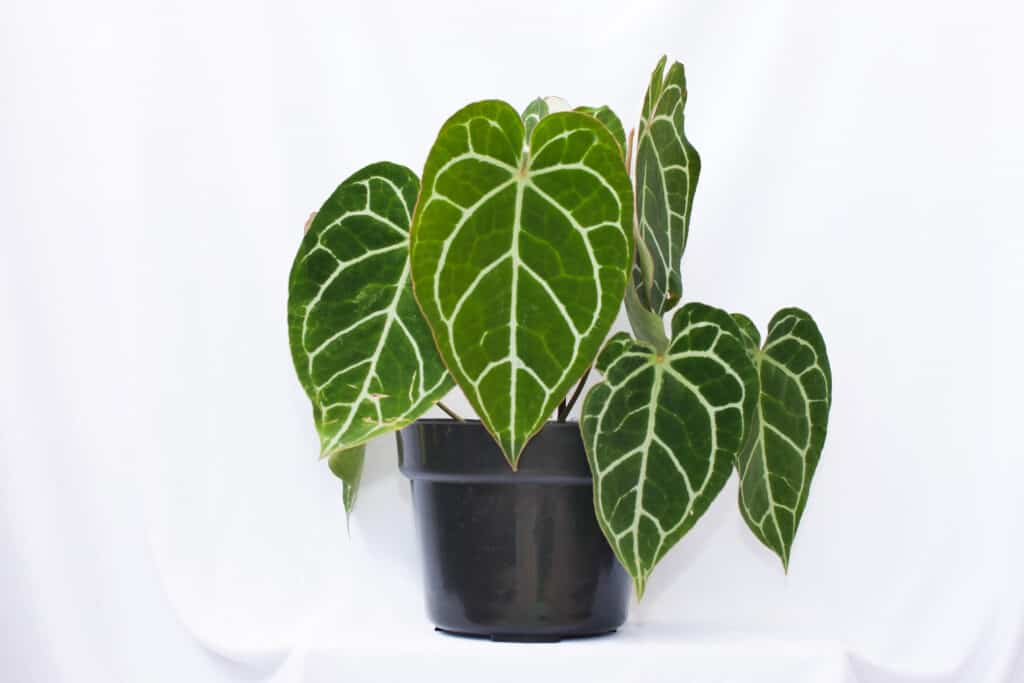
The plants of the aroid family love humidity and will thrive in this DIY indoor potting soil mixture.
©Masdim Photography/Shutterstock.com
Most aroids, including orchids, African violets, anthuriums, peace lilies, philodendrons, pothos, and Monsteras, will all love this mixture. It is high in oxygen flow and holds moisture without being soggy. It is also full of organic material that adds nutrients to the plant slowly.
- Use a base of 2 gallons of bark chips.
- Add 1 gallon of coco coir (coco fiber).
- Add 1 gallon of pumice.
- Add 1 gallon of perlite.
- Mix in 1 gallon of compost.
The photo featured at the top of this post is © Shadow Inspiration/Shutterstock.com
Thank you for reading! Have some feedback for us? Contact the AZ Animals editorial team.







